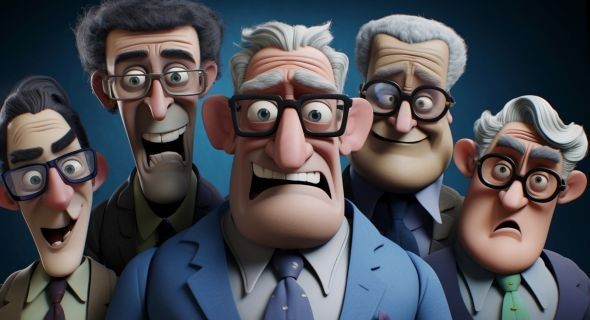
How to Design the Best Caricatures: A Step-by-Step Guide
Caricature art takes a person's look and plays with it. It mixes a true likeness with funny, over-the-top features. You see this art everywhere, from gifts for friends to live events where artists draw on the spot.
There's real joy in drawing a face someone instantly knows, but that also makes them laugh. Making a recognizable, amusing portrait feels rewarding. While it does take some skill, anyone can learn the steps to create great caricatures. This guide will show you how.
You will learn the basic rules and useful tricks for designing top-notch caricature art. This article covers everything from finding the right tools to mastering advanced drawing methods. Get ready to boost your artistic journey.
Understanding the Fundamentals of Caricature
What Makes a Good Caricature?
A great caricature stands out. First, it must be easy to spot who it is. Second, it needs to have features that are clearly stretched or blown up. Think of a very big nose or tiny eyes. Finally, it should show a bit of the person's real spirit or mood. This differs from a simple portrait, which aims for a perfect copy. Caricatures aim for a memorable, humorous take.
Key Principles: Exaggeration and Distortion
Exaggeration means making a feature much bigger or smaller than it is. Does your subject have a long chin? Make it longer. Are their ears tiny? Make them almost disappear. Distortion is about changing how parts fit together without losing the person's face. You might squish the head or stretch the neck. This changes shapes but keeps the person in mind. The trick is to push things far but not too far.
The Importance of Observation
Seeing small details is vital for caricature artists. You need to really look at faces. Notice the way someone's eyes crinkle when they smile. See if their nose turns up slightly. Check for a unique line in their jaw. These small points become your biggest tools. Learning to observe helps you find what makes each person special.
Gathering Your Caricature Tools and Materials
Traditional Drawing Tools
You'll need a few key items for drawing by hand. Pencils come in different hardness levels; use softer ones for dark lines and harder ones for light sketches. Erasers are a must for fixes, like a kneaded eraser for gentle lifts or a block eraser for stronger cleans. Good paper helps a lot. Smooth paper works well for crisp lines, while textured paper can add character. Sometimes artists use charcoal or pastels for different looks and feels.
Digital Drawing Tools and Software
Many artists now work on computers. Drawing tablets, like those from Wacom or Huion, let you draw right on a screen or pad. They come with a stylus, which is like a digital pen. Popular software includes Procreate for iPads, Photoshop, and Clip Studio Paint. Digital tools let you undo mistakes with ease. You can also work on different layers, making changes simple.
Choosing the Right Medium for Your Style
The tools you pick change how your caricature looks. Watercolor can give a soft, dreamy effect. Digital art often has clean, sharp lines and bright colors. Using pens can make your work look bold and comic-like. Think about the style you want to achieve. Each medium offers a unique feel to your finished art.
The Caricature Design Process: Step-by-Step
Subject Selection and Reference Gathering
Picking the right person is your first step. Good quality photos are super important. Look for pictures that show clear facial features. Photos taken from different angles or with strong lighting often show key traits best. These details will help you exaggerate later.
Actionable Tip: Take many reference photos from various angles. This helps you capture the full shape of their face and head.
Sketching the Basic Structure and Proportions
Begin by drawing a light, simple head shape. This is your foundation. Then, lightly sketch where the main parts of the face will go. Think about the eyes, nose, and mouth. Even though you will exaggerate later, it's good to start with a roughly correct layout. This sets up your drawing for success.
Identifying and Exaggerating Key Features
This is the heart of making a caricature. Look closely at your reference photo. What parts of the face stand out the most? Is it a big smile, a pointy nose, or a wide jaw? Once you find these, decide how you will make them bigger or bolder. A common trick is to make a large nose even larger. You might give someone with a round face an even rounder one. Artists like Al Hirschfeld, known for his theater drawings, often made limbs and torsos much longer to add to the fun.
Refining Lines and Adding Detail
After your main sketch, clean up your lines. Make your chosen lines darker and clearer. Add the smaller details that bring your drawing to life. Think about how to draw hair texture, the folds in clothing, or specific accessories. These small touches help build personality. They make the caricature feel more like the person.
Adding Shading and Color (Optional)
If you choose to, adding shading can make your caricature look more three-dimensional. Use darker tones in areas where shadows would naturally fall. This gives your drawing more depth and form. When adding color, pick shades that fit the subject and boost the funny exaggeration. Bright colors can make a caricature pop.
Mastering Caricature Techniques and Styles
The "Feature Focus" Method
This method zeroes in on one or two dominant features. If someone has a very distinct chin, you might make that the star of your drawing. This helps to create a quick, strong impression. The viewer's eye goes right to that exaggerated part. It makes the caricature instantly memorable.
The "Overall Proportion Shift" Method
Sometimes, it's not just one feature, but the whole head or body that gets changed. You might make a person's head very small on a big body. Or maybe their neck becomes super long. This changes the entire outline of the person. It creates a silly or interesting effect. This method can add a lot of humor.
Incorporating Personality and Expression
Caricatures are more than just stretched features. They should show the person's character. How do they usually look? Are they serious, happy, or sly? Use their expression to help tell their story. A wide grin or a raised eyebrow can say a lot. Their pose can also add to the feeling.
Actionable Tip: Study how faces move when people show feelings. Watch how muscles work to create smiles or frowns. This will help you draw stronger, more emotional exaggerations.
Exploring Different Caricature Styles
Caricature art has many forms. Some artists aim for exaggerated realism, where it still looks like a real person, just pushed. Others go for a cartoonish style, making figures look more like comic book characters. Some even use abstract shapes. Great artists like Mort Drucker or Tom Richmond each have a unique look. Learning from various artists helps you find your own way. Developing a personal style is a key part of becoming a master.
Common Challenges and How to Overcome Them
Maintaining Likeness While Exaggerating
A common problem is making features too big or too small. When you exaggerate too much, the person might become unrecognizable. The trick is to find a good middle ground. Push the features, but make sure the viewer can still tell who it is. Practice drawing the same person multiple times. Try different levels of exaggeration each time.
Dealing with Difficult Features
Some people have very subtle features. This can be hard to exaggerate. Look for hidden traits. Maybe it’s a specific way their hair falls, or a unique tilt of their head. Sometimes, you need to slightly invent or highlight a minor detail to give it more punch. Pay attention to how the eyes are set or the shape of the mouth when relaxed.
Avoiding Unflattering or Offensive Depictions
The goal of caricature is to be funny and light-hearted. It should never be mean or rude. Make sure your exaggerations are good-natured. Focus on features that are visually interesting, not those that might hurt someone's feelings. Always aim for playful humor. Respect for the subject is very important.
Practicing and Developing Your Skills
Becoming good at caricature takes time and lots of drawing. Keep practicing regularly. Try drawing people you know, or even strangers in public places. Studying anatomy, or how the body is built, can help too. Ask friends or other artists for their thoughts on your work. Getting feedback helps you see what to improve. Just like any skill, consistent effort makes you better.
Conclusion: Your Journey to Becoming a Caricature Master
Designing a great caricature moves from knowing the basics to mastering advanced tricks. You start by observing and finding key traits. Then, you choose your tools and begin to sketch. The process involves pushing features, refining your lines, and adding personality.
Remember, practice is key. Keep observing people and finding what makes them unique. Understand how to push and pull features without losing the person's true self. Embrace every drawing as a chance to learn more. And most of all, have fun with the process.
The joy of creating a caricature lies in making people smile. It’s about crafting a funny, yet truthful, picture that captures someone's spirit. Start drawing today, and watch your skills grow.
